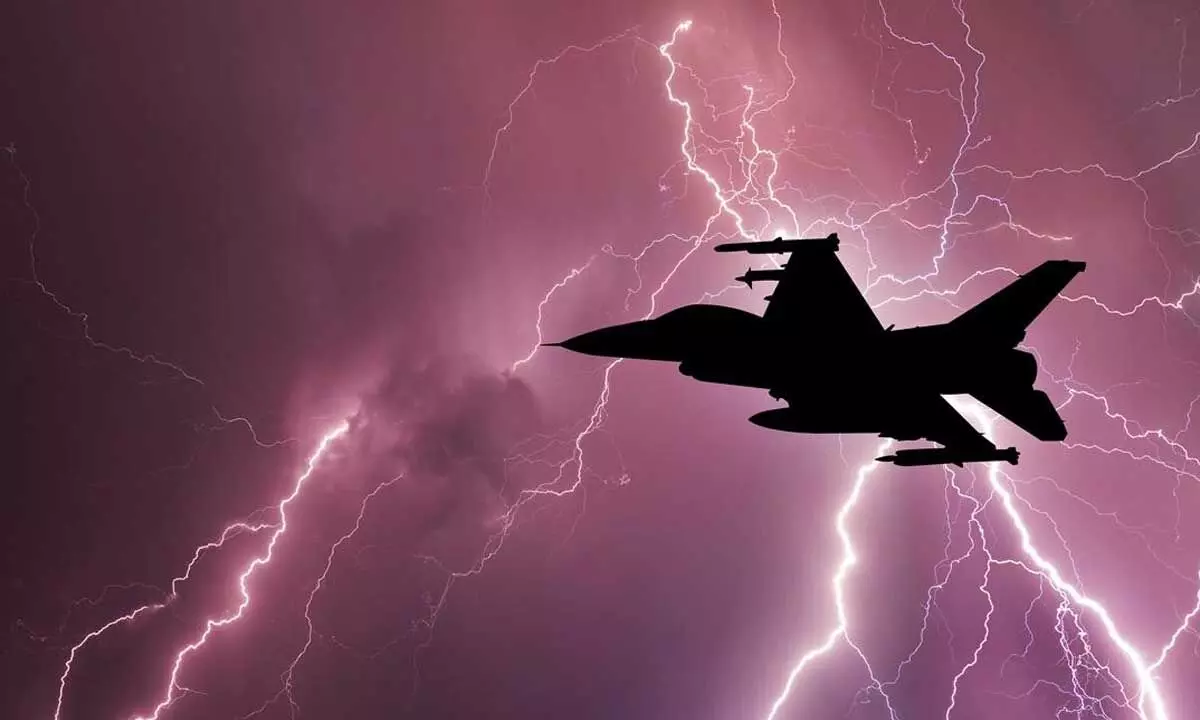Live
- Globus Spirits Limited introduces India Single Malt under the brand DŌAAB India Craft Whisky
- BGT 2024-25: No greater honour to lead India in Test cricket, says Bumrah ahead of series opener
- NMO Bharat calls for apology from Rahul Gandhi over ageist remarks about Joe Biden
- Centre blocks 17,000 WhatsApp accounts of hackers from South-East Asia
- Learn from Mumbai hoarding collapse, Calcutta HC tells Bengal municipal corporation
- Russian Spokesperson Instructed to Stay Silent on ICBM Strike During Press Conference: Viral Video
- Intellipaat Sets New Benchmark with First-of-its-kind Physical Labs for Electric Vehicle Training in Chennai and Pune
- Google Gemini AI Introduces Memory Feature Like ChatGPT: How It Enhances Personalized Interactions
- Latur beneficiaries get affordable houses under PMAY, thanks Modi govt
- Rajasthan HC quashes FIR against Shilpa Shetty under SC/ST Act
Just In
IISc model to help protect aircraft from lightning strikes


IISc model to help protect aircraft from lightning strikes
Usually, an aircraft gets struck by lightning once every 1,000 hours, says Udaya Kumar, Professor at the Department of Electrical Engineering, IISc, whose lab has been investigating this phenomenon in recent years
Bengaluru: Researchers at the Indian Institute of Science (IISc) have developed a unique computational model to simulate how lightning can strike an aircraft. The insights they have gleaned from this model can help design better lightning protective measures for aircraft.
While lightning strikes can be dangerous for aircraft, studying this phenomenon in the field is quite difficult. Lightning strikes can damage the aircraft surface, lead to temporary disruptions in electrical and electronic systems or even cause permanent damage, and in extreme cases, cause ignition of the fuel-air mixture around the engine, leading to an explosion, an IISc release stated.
"Usually, an aircraft gets struck by lightning once every 1,000 hours," says Udaya Kumar, Professor at the Department of Electrical Engineering, IISc, whose lab has been investigating this phenomenon in recent years. "There have been a lot of incidents in the last century where things have been very catastrophic."
The first step in protecting aircraft from lightning is identifying the most common regions on the aircraft where lightning can attach or hit. Kumar and his team realised that current approaches to this identification were grossly oversimplified and set out to develop a more comprehensive computational model. The model and the data obtained from it have been published in Atmosphere.
Kumar's lab has been studying lightning protection for the past few years. In previous studies, his team has analysed the effectiveness of lightning rods in safeguarding tall buildings in a thunderstorm. They have developed unique models that have addressed several long-standing issues of lightning current evolution. In the past, he was also involved in the design of a lightning protective system for Indian satellite launch pads and has conducted research on different protective schemes. In the current study as well as in ongoing work, they have focused on modelling how lightning impacts aircraft, in order to develop suitable protective measures.
In the usual downward cloud-to-ground lightning, leaders - precursors to lightning arcs - are initiated at the cloud, which propagate towards the ground. However, field data, as well as the model developed, clearly show that in more than 90 per cent of the cases, the leader discharges are initiated at the aircraft. The model developed by the IISc team is applied to two different aircraft geometries: a DC10 passenger aircraft and the SDM fighter aircraft model. It involves extensive computation of the electric field around the aircraft and suitable modelling of the electrical discharges.
ith the model, the scientists were able to obtain estimates of the minimum ambient electric field required for initiation of lightning leader discharges from the aircraft.
These values, the researchers say, are in good agreement with measured data from instrumented aircraft flown through thunderstorms, such as NASA's Storm Hazard Program.
Moreover, the aircraft is not perfectly parallel to the ground during take-off and landing, and the model is able to simulate how these changes in orientation can affect the electric field. The role of atmospheric conditions such as humidity and air pressure are also taken into account in the model. It also showed that aircraft at higher altitudes had a greater affinity for lightning strikes.
In ongoing studies, the team is planning to investigate several related issues.
Firstly, what could be the peak value of the lightning stroke current for aircraft-initiated lightning? Secondly, what could be the local changes around the aircraft during the lightning strike evolution? In addition, they are investigating disruptions to the internal electrical equipment when struck by lightning.
Kumar's lab has also carried out a first-of-its-kind experiment on a small military aircraft by injecting it with enormous amounts of current a" intended to emulate lightning discharge - and by collecting electric field data from inside the craft.

© 2024 Hyderabad Media House Limited/The Hans India. All rights reserved. Powered by hocalwire.com






